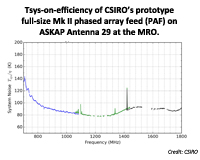ASKAP PAF performance signficantly improved with Mk II system
Click on the image for more detail.
The installed Mk II phased array feed. Click on
the image for more detail.
19 February 2015
On-dish measurements from CSIRO’s newest phased-array feed (PAF) have confirmed low-noise performance across the entire ASKAP frequency band.
Results for the Mk II PAF, installed on ASKAP Antenna 29 at the Murchison Radio-astronomy Observatory, show a doubling of the low-noise bandwidth when compared to the Mk I PAF.
The Mk II results demonstrate:
- Doubled sensitivity and quadrupled survey speed above 1,400 MHz (compared to the Mk I)
- A minimum system-temperature-on-efficiency of 78 K at 1,230 MHz
- System-temperature-on-efficiency of 95 K or better across the 835–1,800 MHz range
For this work, observations of a standard astronomical source – Taurus A – were held over two days in 2014. Beamforming and sensitivity measurements were made using 10s integration for both on-source and off-source (empty sky) target positions. The measurements were made for a single-polarisation boresight beam with maximum signal-to-noise ratio weights.
The gaps in the data at certain frequencies are due to radio transmissions from satellites that are stronger than Taurus A in this single dish measurement. Some of these gaps will be removed when the full ASKAP can use its 36 dishes to significantly boost the ratio of astronomical signal to unwanted satellite signal in the beamforming process.
“Doubling the low-noise bandwidth achieved on dish is a fantastic preliminary result for CSIRO’s first Mk II PAF,” says Dr Aaron Chippendale, ASKAP research engineer, “This is a great step for the enhanced system. The next steps will involve repeating these measurements for two orthogonal linear-polarisation beams – closer to what we will use in ASKAP operation.”
The significant improvement in performance was achieved through a design enhancement program aimed at developing a second generation ASKAP receiver that offers significant benefits in system performance. This included more accurate experimental characterisation of the low-noise amplifier (LNA) signal and noise parameters, and enhancement of the chequerboard array to better match these parameters.
The system design was further modified for better operability and maintainability through new technologies and assembly techniques and novel components designed especially by CSIRO for ASKAP. Key innovations have included full adoption of optical fibre to transport all signals to the central signal processor, up to six km away, the adoption of thermoelectric cooling.
The development of the Mk II PAF system builds on lessons learnt with the design, development, construction, and commissioning of the Mk I receiver, six of which are currently being commissioned at the MRO and producing valuable science results as the Boolardy Engineering Test Array (BETA).
The Mk II PAF was installed on ASKAP Antenna 29 in September 2014, and has operated reliably at the MRO since that time, even throughout the hot Australian summer.
Back to Latest ASKAP News page.


